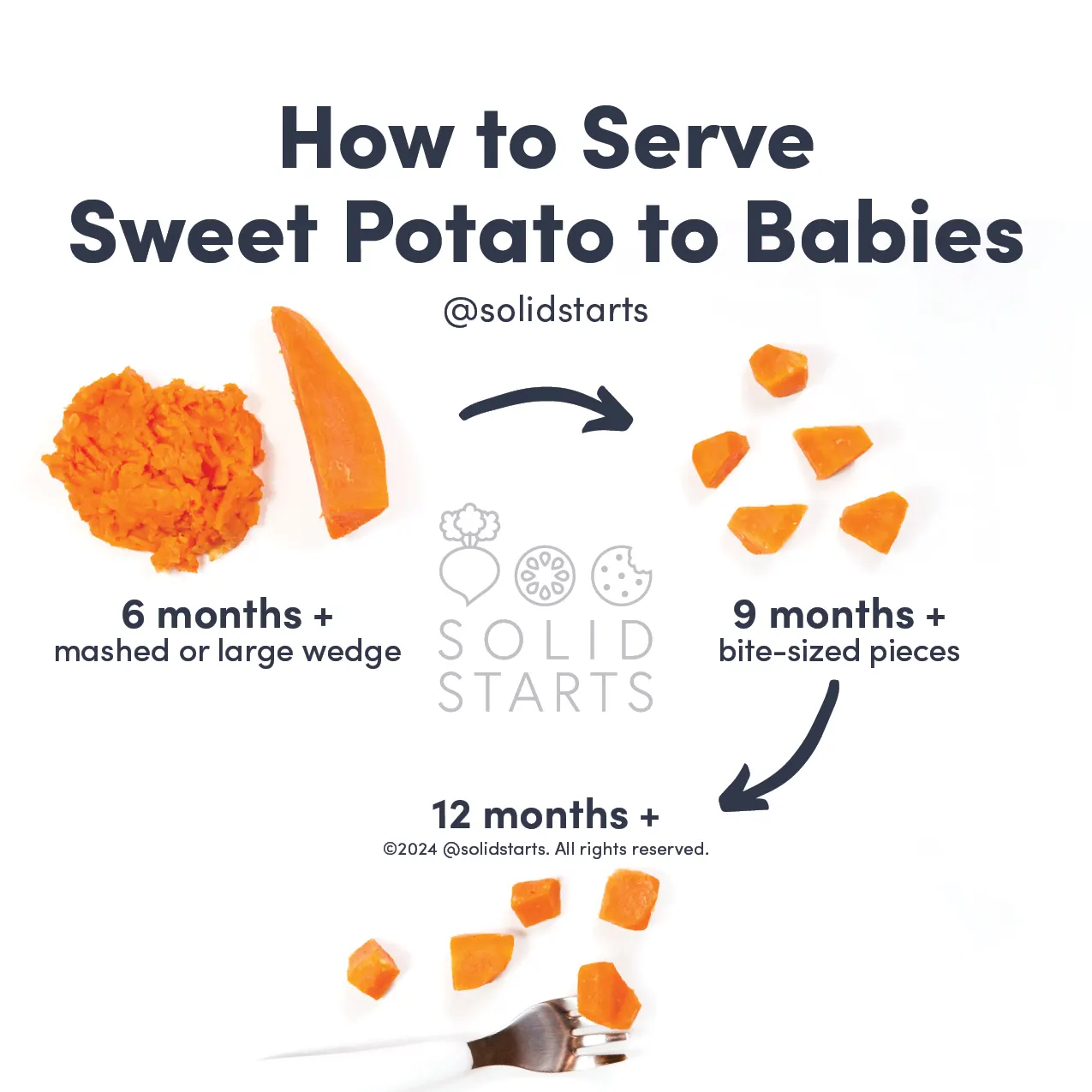Sweet Potato
Vegetable
Age Suggestion
6 months
Iron-Rich
No
Common Allergen
No

When can babies have sweet potato?
Sweet potatoes may be introduced as soon as baby is ready for solids, which is usually around 6 months of age.
Sweet potato goes by many names: apichu, camote, dìguā, goguma, kumara, and satsumaimo to name a few. Its name in Spanish, batata, comes from the language of the Taino people of the American tropics, where sweet potato originated. Another common name is yam, a word used interchangeably with sweet potato in North America. Though the two tubers are botanically different, they are connected by history. In the United States, sweet potatoes were an important food for enslaved people from Africa, who referred to the tuber as “yam” since it resembled yams from Africa.
Are sweet potatoes healthy for babies?
Yes. Sweet potatoes are rich in carbohydrates, fiber, potassium, and zinc. They also offer vitamins A (mainly in the form of beta carotene), B6, C, E, and K. Together, these nutrients support energy for growth and play, a flourishing gut microbiome, immunity, metabolic processes, iron absorption, blood clotting, and many other important bodily functions.
Like many other foods, sweet potatoes can contain trace amounts of heavy metals (such as lead and arsenic) as a result of residues of pollution from the environment in which they grow. This also impacts organically grown sweet potatoes. Fortunately, it is not necessary to avoid sweet potatoes and it is fine to offer sweet potatoes as part of a varied diet.
Are sweet potatoes a common allergen?
No, sweet potatoes are not a common cause of IgE-mediated allergies, although allergies to sweet potatoes have been reported. In theory, an individual can be allergic to any food. Oral Allergy Syndrome (also called pollen food allergy syndrome) to sweet potato has also been reported. Oral Allergy Syndrome typically results in short-lived itching in the mouth and is unlikely to result in a dangerous reaction. Cooking sweet potato can minimize the reaction.
However, sweet potatoes can be a trigger for FPIES—food protein-induced enterocolitis syndrome, a relatively uncommon food allergy in children that can be severe and life-threatening. Unlike most food allergy reactions that occur within minutes of contact with a specific food trigger, FPIES allergic reactions occur within hours after consuming a particular food. For this reason, FPIES is sometimes known as a delayed food allergy. Symptoms include delayed vomiting (typically 1-4 hours after ingesting the food trigger) and/or experiencing diarrhea 5-10 hours after ingestion. Other symptoms include low blood pressure, low body temperature, extreme pallor, repetitive vomiting, and significant dehydration. Thankfully, most cases of FPIES will completely resolve during toddlerhood. Children who have been diagnosed with FPIES must be followed closely by an allergist or immunologist. If your baby has pre-existing FPIES to another food, talk to your allergist about how best to introduce other solid foods that may have a higher risk for inducing FPIES.
As you would when introducing any new food, start by offering a small quantity for the first few servings. If there is no adverse reaction, gradually increase the quantity over future meals.
Are sweet potatoes a choking hazard for babies?
No. Cooked, soft sweet potato presents a low risk when safely prepared for a child’s age and developmental ability, though, in theory, an individual could choke on any food. To reduce the risk, prepare and serve sweet potato in an age-appropriate way as described in the How to Serve section. As always, make sure you create a safe eating environment and stay within an arm’s reach of baby during meals.
Learn the signs of choking and gagging and more about choking first aid in our free guides, Infant Rescue and Toddler Rescue.
Videos
What are the signs of readiness for solids?
Baby should be able to sit with minimal support, hold their head up well, and be able to reach and grab an item and successfully bring it to their mouth while seated. Baby should also show interest in eating and watching caregivers eat. For example of babies who are ready vs not, see our article on readiness.
What are some great first foods for babies?
There are many wonderful options. Look for foods that are easy for baby to feed to themselves, that are low in choking risk, and that offer nutrients babies need, such as iron. Some of our favorite first foods include steamed broccoli, oatmeal, and mango pits. See more ideas in our guide, 50 Fantastic First Foods.
How do you serve sweet potatoes to babies?
Every baby develops on their own timeline, and the suggestions on how to cut or prepare particular foods are generalizations for a broad audience.
6 months old +:
Offer wedges of fully cooked, soft sweet potato for baby to hold and munch on, with skin still on or removed. You can serve mashed cooked sweet potato, with other ingredients mixed in for flavor or added nutrition as desired (breast milk or formula, butter or yogurt, your favorite powdered spices, etc.) If you’d like to encourage use of a utensil, pre-load a spoon and rest it next to the food for baby to try to pick up or pass it in the air for baby to grab.
9 months old +:
Serve bite-sized pieces of cooked, soft sweet potato for baby to practice picking up with their developing pincer grasp (where the thumb and pointer finger meet to pick up smaller pieces of food). You can also offer cooked sweet potato spears for practice with biting and managing bigger pieces of food. Serve the pieces with the skin still on or remove it, as desired. Babies often chew on the skin and spit it out, and while this can seem like waste, building familiarity with skin can help encourage a child to eat fruits and vegetables with the skin later in life. Lastly, you can continue serving mashed sweet potatoes for baby to eat with their hands or a utensil.
12 months old +:
Continue serving cooked, soft sweet potato in bite-sized pieces or larger wedges, as desired. You can also take this opportunity to encourage utensil practice: offer bite-sized pieces of cooked sweet potato along with a fork and help show how it’s done by pre-loading the fork for the child to pick up independently. You can also try spearing the sweet potato while making a sound (boink!) to make it fun to use the utensil. If the child is not interested in using a fork or spoon, keep in mind that using utensils can be exhausting for new eaters, and many children toggle back and forth between feeding themselves with their fingers and utensils. Try not to apply too much pressure—consistent and accurate utensil use will come in due time—often sometime after the second birthday.


Is baby truly ready to start solid foods? Learn more on our Readiness page.
Our Team
Written by
Expert Tips Delivered to Your Inbox
Sign up for weekly tips, recipes and more!
Copyright © 2024 • Solid Starts Inc






